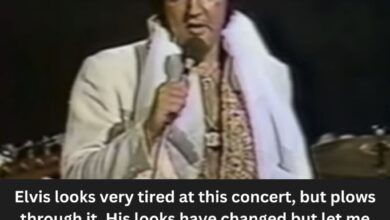George Jones’s “She Thinks I Still Care” Transforms Country Heartbreak into a Chart-Topping Masterclass in 1962
When George Jones released “She Thinks I Still Care” in 1962, few could have predicted the emotional hurricane it would stir within the country music world. The song, with its aching melody and nuanced vocal delivery, didn’t just climb the charts—it lingered in the hearts of listeners, claiming the No. 1 spot on the Billboard country chart and staying there for six weeks. This wasn’t just another hit—it was a statement. It signaled a new level of emotional complexity in country songwriting and solidified Jones’s role as a master interpreter of sorrow. In a genre already defined by heartbreak, “She Thinks I Still Care” set a new benchmark for sincerity.
George Jones was already a respected figure in country circles by 1962, but he hadn’t yet reached the iconic status that would define his later years. Born in Texas and raised on the sounds of Hank Williams and Roy Acuff, Jones had a natural twang in his voice and an uncanny ability to emote. His early hits, like “White Lightning” and “Tender Years,” had given him credibility, but his reputation was still growing. What set him apart wasn’t just his vocal range—it was his phrasing, the almost conversational quality he brought to a lyric, as though he were living every line rather than merely singing it. “She Thinks I Still Care” would showcase that gift in full bloom.
The song itself had humble origins. It was penned by Dickey Lee and Steve Duffy, two Nashville songwriters who weren’t yet household names. According to Lee, the song came about quickly, inspired by the simple but universal idea of pretending not to care when, in fact, you’re drowning in emotion. When George Jones first heard the demo, he reportedly didn’t think much of it—until producer Pappy Daily urged him to take another listen. The genius of the song lay in its subtlety: the narrator never admits he still cares, but every line contradicts his claims. That duality gave Jones the perfect vehicle for the emotional nuance he excelled at.
Recording took place in the legendary Quonset Hut Studio in Nashville, a space known for birthing many country classics. The production was minimal yet hauntingly effective. Steel guitar wept behind Jones’s vocal, while the piano lines hovered delicately, adding emotional punctuation. Jones’s vocal approach was slow and deliberate, lingering on words like “telephone” and “old friend” as though each held a memory too heavy to carry. Pappy Daily kept the instrumentation sparse, allowing Jones’s voice to command full attention. The result was not just a recording—it was a performance that felt lived-in, like an emotional confession whispered late at night.
Upon its release, “She Thinks I Still Care” shot up the charts with impressive speed. It became George Jones’s third No. 1 hit on the country chart, but unlike his earlier up-tempo songs, this ballad had staying power. It held the top position for six weeks and remained on the chart for a total of 23. The single not only brought Jones new commercial success but also critical acclaim. Fans and critics alike recognized it as a turning point, a sign that country music was capable of deeper psychological storytelling. In an era of jukeboxes and AM radio, the song’s mournful tone stood out.
Culturally, the song tapped into a national mood. America in the early ’60s was standing on the edge of enormous change. The innocence of the postwar era was beginning to fade, and popular music was reflecting more nuanced emotional realities. In that context, “She Thinks I Still Care” resonated beyond country boundaries. It brought to light the quiet, unresolved sorrow that often hides behind masculine pride. The song wasn’t just about a man missing a woman—it was about denial, emotional repression, and the subtle ways grief leaks out when you’re trying to keep it in.
For George Jones, the impact was profound. This song marked the beginning of a golden era in his career. It expanded his audience and gave him the artistic credibility he had long deserved. Concertgoers now came not only for the hits but for the heartache. The song opened doors for more mature material and helped pave the way for later masterpieces like “The Grand Tour” and “He Stopped Loving Her Today.” It was no longer just about being a honky-tonk singer—Jones had become a voice for the emotionally wounded.
“She Thinks I Still Care” also had ripple effects on the genre itself. It helped usher in the Nashville Sound era, where lush, emotional arrangements met traditional country themes. Artists like Tammy Wynette, Merle Haggard, and even Elvis Presley would later build on the emotional framework Jones helped refine. The song proved that vulnerability could be a strength in country music—that a man confessing hurt could move mountains.
Its influence was cemented through the many artists who chose to cover it. Notably, Connie Francis offered a female perspective with “He Thinks I Still Care,” flipping the gender but keeping the emotional weight intact. Elvis Presley gave a deeply personal rendition during his 1973 sessions, adding a layer of weariness that only age and experience could provide. Anne Murray, Glen Campbell, and even Leon Russell would put their stamp on the song, each drawn to its timeless core of denial and longing.
At the time of the song’s release, Jones’s personal life was already starting to reflect the turbulence that would define much of his later years. His marriage to fellow country star Tammy Wynette was still in the future, but his struggles with alcohol were beginning to cast a shadow. “She Thinks I Still Care” would become both an artistic high point and, in hindsight, a haunting foreshadowing of the emotional battles to come.
Decades after its release, the song continues to enjoy radio play and high placements in “Greatest Country Songs” lists. Its legacy is not merely one of commercial success but of emotional truth. It remains one of the definitive breakup songs in country history—often imitated, rarely equaled. In a world where heartbreak is a dime a dozen in lyrics, this song still manages to make the listener feel something new.
“She Thinks I Still Care” also helped set a standard for production and vocal delivery that would influence generations. The minimalist approach—letting the vocal performance carry the narrative—became a model. Later artists like Alan Jackson and George Strait would borrow liberally from this style, allowing emotional authenticity to lead the way.
Though George Jones would go on to receive many honors, including a Grammy Lifetime Achievement Award and induction into the Country Music Hall of Fame, many still point to this song as the moment when he truly became a legend. It was the song that showed the full range of what he could do—not just as a singer, but as a storyteller.
Ultimately, “She Thinks I Still Care” endures because it captures a universal moment with absolute precision: the space between what we say and what we feel. It’s a masterclass in emotional restraint, a monument to heartache, and one of the clearest examples of how country music, at its best, tells the truth better than anyone else can.



